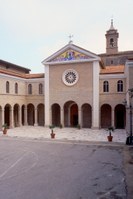Shrine of Madonna of Splendour
The apparition of the Virgin Mary
The legend tells that on the 22nd of April of 1557 a farmer called Bertolino, saw a dazzling light while resting under an olive tree. At the centre of the intense light there was the smiling Virgin who asked him to tell the community her desire to have a shrine built in that spot. However, people did not believe him and he was ridiculed, sent away and rebuked to the point that he too doubted he had seen something.
Another apparition encouraged him and again he went to the Governor to put forward the Virgin’s request. The Governor who could not stand further the farmer’s persistence asked one of his servants to beat him up ruthlessly. But the Virgin paralyzed him and made him unable to speak.
Astonished and frightened for what had happened the Governor went to the spot indicated by Bertolino along with other people and there the faithful clearly saw the radiant Virgin Mary. Also, a spring of pure water gushed out at the foot of the olive tree and it is still there. The first person who was miraculously healed by the water was that servant who had beaten Bartolino. He could move and speak again.
Up today, whoever touches the spring’s water receives the blessing of the Virgin Mary.
The miraculous spring
Restoration works reinstated the ancient ‘bath’ where six taps draw the water from the miraculous spring and supply the faithful.
A marble bas-relief represents the water as symbol of life; the image is of a pilgrims’ procession along the Jordan River and it concludes with Jesus baptism. A polychromatic mosaic above the basins represents the miracle of Naaman, the man who healed from leprosy after taking a bath in the Jordan River. Instead, another mosaic depicts a procession of ill people with Betolino on his knees.
The polychromatic marble flooring indicates a cross upon which two Greek letters intersect meaning ‘light’ and ‘life’. Whereas the twelve stars of the Virgin Mary’s crown interject the twelve beams propagating from the cross. The water constantly gushing out from the collecting basins falls into a small swimming pool lined in mosaics; here one can take a plunge. An old niche is back to its spot, which is where the water falls. Inside the niche, upon a bed of olive leaves, which also are in the swimming pool floor, there is a stunning golden bronze statue of the Virgin Mary holding her Child towards the water.
Outside on the background of a travertine porch one can see another big mosaic depicting Jesus giving sight to a man born blind by the pool of Siloe. Just in front, a life-size bronze statue of Saint Francis lifts his arms to praise the Creator in eternity. On either side two bronze sculptures represent the angels who ask to pray in silence.
The bronze statue of the Archangel Gabriel stands out from a small square overlooking the Adriatic Sea. He wears his elm and armour, carries an inflamed sward, and crushes Satan’s head with his left foot. This image reminds the unique intercession of the Madonna of Splendour to help the possessed.
The Shrine
The Shrine of Madonna of Splendour is one of the most popular worship places of Teramo’s province.
Until early 1800 the Celestine Fathers, who were living in the monastery next to the little church, were entrusted with the spiritual care of the Shrine. When the convents were suppressed and the religious orders expelled with force, the building became a private hospital and a nursing home. Afterwards the local authorities entrusted the Chapel/Shrine to some Capuchin-Franciscan Friars.
Since then this religious order has taken care of the Shrine by extending the sacristy, building a new choir and new rooms in the convent and erecting a bell tower. Later, the Shrine experienced further vicissitudes that gradually modified the original ground plan.
In 1937 the little church was extended and converted into the present building through the donations of the faithful. It presents a Latin cross plan with three altars, the choir, halls on either side and a front porch completed in 1959.
At the end of the Second World War, the population of Giulianova commissioned for the church a new altar in polychromatic marbles to show gratitude to the Madonna for sparing the town from destruction. Above the altar a little temple lodges the Madonna of Splendour.

















